Componente: Concepto
Organiza tus páginas con colecciones
Guarda y categoriza el contenido según tus preferencias.
Elemento: Concepto / información
| Espacio de nombres |
http://schemas.google.com/dspl/2010 |
| Anotaciones |
Información textual, como el nombre y la descripción del
un concepto de diseño de producto. |
| Diagrama |
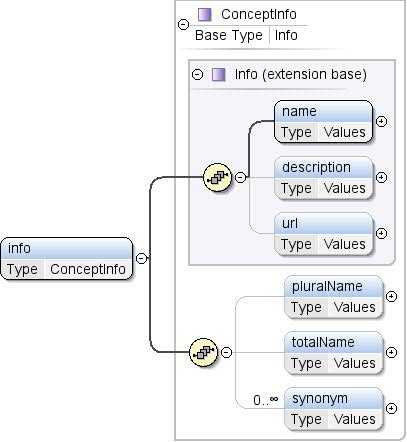 |
| Tipo |
ConceptInfo |
| Jerarquía de tipos |
|
| Propiedades |
|
| Modelo |
name , description{0,1} , url{0,1} , pluralName{0,1} , totalName{0,1} , sinónimo* |
| Niños |
description, name, pluralName
sinónimo, totalName, url |
| Instancia |
<info>
<name>{1,1}</name>
<description>{0,1}</description>
<url>{0,1}</url>
</info>
|
| Fuente |
<xs:element name="info" type="ConceptInfo">
<xs:annotation>
<xs:documentation>Textual information, such as the name and description of
the concept.</xs:documentation>
</xs:annotation>
</xs:element>
|
Elemento: Concepto / tema
| Espacio de nombres |
http://schemas.google.com/dspl/2010 |
| Anotaciones |
Un tema con el que está asociado el concepto. |
| Diagrama |
 |
| Propiedades |
| content: |
complejo |
| mín.Ocurre: |
0 |
| maxOccurs: |
no delimitado |
|
| Atributos |
| QName |
Tipo |
Fijo |
Predeterminado |
Usar |
Anotación |
| referencia |
xs:QName |
|
|
opcional |
El identificador único del tema en el que se basa este concepto
asociados. El tema al que se hace referencia se puede definir en el mismo
de forma externa, es decir,
en otro conjunto de datos. Es una referencia a un
tema externo debe tener el siguiente formato:
"prefix:other_topic_id", donde "prefix" es el
prefijo utilizado para el espacio de nombres del conjunto de datos externo (consulta XML
espacios de nombres). |
|
| Fuente |
<xs:element name="topic" minOccurs="0" maxOccurs="unbounded">
<xs:annotation>
<xs:documentation>A topic the concept is associated with.</xs:documentation>
</xs:annotation>
<xs:complexType>
<xs:attribute name="ref" type="xs:QName">
<xs:annotation>
<xs:documentation>The unique identifier of the topic this concept is
associated with.
The referenced topic may be defined in the same
dataset or externally, i.e., in another dataset. A
reference to an external topic must be of the form
"prefix:other_topic_id", where "prefix" is the prefix
used for the namespace of the external dataset (see
XML namespaces).</xs:documentation>
</xs:annotation>
</xs:attribute>
</xs:complexType>
</xs:element>
|
Elemento: Concepto / tipo
| Espacio de nombres |
http://schemas.google.com/dspl/2010 |
| Anotaciones |
Es el tipo de datos del concepto. Un concepto debe proporcionar un tipo
una declaración o extiende otro concepto. En caso de que sea
que extiende un concepto, también puede proporcionar una declaración de tipo. El tipo de
El concepto extendido debe ser menos restrictivo que el tipo de
que la extiende. "Menos restrictivo que" (LRT) es un
orden parcial definido de la siguiente manera: string LRT float float LRT entero
string LRT fecha string LRT booleano |
| Diagrama |
 |
| Propiedades |
| content: |
complejo |
| mín.Ocurre: |
0 |
|
| Atributos |
|
| Fuente |
<xs:element name="type" minOccurs="0">
<xs:annotation>
<xs:documentation>The data type of the concept. A concept must provide a type declaration or extend
another concept. In the case where it's extending a concept, it may also
provide a type declaration. The type of the extended concept must be less restrictive
than the type of the concept extending it.
"Less restrictive than" (LRT) is a partial order defined as follows:
string LRT float
float LRT integer
string LRT date
string LRT boolean</xs:documentation>
</xs:annotation>
<xs:complexType>
<xs:attribute name="ref" type="DataType" use="required"/>
</xs:complexType>
</xs:element>
|
Elemento: Concepto / atributo
| Espacio de nombres |
http://schemas.google.com/dspl/2010 |
| Anotaciones |
Es un atributo del concepto. Los atributos representan funciones
información sobre el concepto (p.ej., el PBI es un porcentaje). |
| Diagrama |
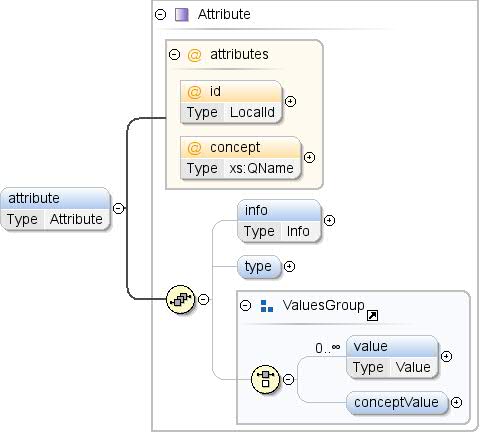 |
| Tipo |
Atributo |
| Propiedades |
| content: |
complejo |
| mín.Ocurre: |
0 |
| maxOccurs: |
no delimitado |
|
| Modelo |
información{0,1} , tipo{0,1} , (valor*
| conceptValue{0,1}) |
| Niños |
conceptValue, info, tipo,
valor |
| Instancia |
<attribute concept="" id="">
<info>{0,1}</info>
<type format="" ref="">{0,1}</type>
</attribute>
|
| Atributos |
| QName |
Tipo |
Fijo |
Predeterminado |
Usar |
Anotación |
| concepto |
xs:QName |
|
|
opcional |
Una referencia a un concepto que corresponde a los valores
del atributo. Si el atributo especifica un tipo, entonces el tipo
debe coincidir con el tipo del concepto al que se hace referencia. Es una referencia a un
El concepto externo debe tener la forma
"prefix:other_concept_id", donde "prefix" es
el prefijo utilizado para el espacio de nombres del conjunto de datos externo (consulta XML
espacios de nombres). |
| id |
LocalId |
|
|
opcional |
Es el ID del atributo del concepto. Este identificador debe ser
únicos dentro del concepto (en todos los atributos y propiedades). El
id se puede omitir si se especifica el atributo de concepto. En ese
caso, un ID se crea implícitamente con el valor el nombre local del
al que se hace referencia. Por ejemplo <attribute
concept="unit:currency"/> equivale a
<attribute id="moneda"
concept="unit:currency"/> |
|
| Fuente |
<xs:element name="attribute" type="Attribute" minOccurs="0" maxOccurs="unbounded">
<xs:annotation>
<xs:documentation>An attribute of the concept. Attributes represent additional
information about the concept (e.g., GDP is a percentage).</xs:documentation>
</xs:annotation>
</xs:element>
|
Elemento: Concepto / propiedad
| Espacio de nombres |
http://schemas.google.com/dspl/2010 |
| Anotaciones |
Es una propiedad del concepto. Las propiedades representan valores
información sobre instancias del concepto (p.ej., un concepto
"ciudad" puede tener una propiedad "país"). |
| Diagrama |
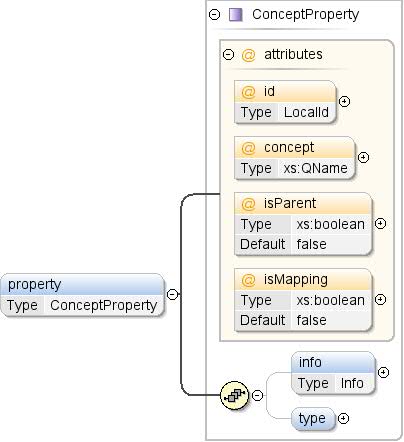 |
| Tipo |
ConceptProperty |
| Propiedades |
| content: |
complejo |
| mín.Ocurre: |
0 |
| maxOccurs: |
no delimitado |
|
| Modelo |
información{0,1} , tipo{0,1} |
| Niños |
información, tipo |
| Instancia |
<property concept="" id="" isMapping="false" isParent="false">
<info>{0,1}</info>
<type ref="">{0,1}</type>
</property>
|
| Atributos |
| QName |
Tipo |
Fijo |
Predeterminado |
Usar |
Anotación |
| concepto |
xs:QName |
|
|
opcional |
Una referencia a un concepto que corresponde a los valores
de la propiedad. Si la propiedad especifica un tipo, entonces el tipo
debe coincidir con el tipo del concepto al que se hace referencia. Es una referencia a un
El concepto externo debe tener la forma
"prefix:other_concept_id", donde "prefix" es
el prefijo utilizado para el espacio de nombres del conjunto de datos externo (consulta XML
espacios de nombres). |
| id |
LocalId |
|
|
opcional |
Es el ID de la propiedad del concepto. Este identificador debe ser
únicos dentro del concepto (en todos los atributos y propiedades). El
id se puede omitir si se especifica la propiedad del concepto. En ese
En este caso, se crea implícitamente un ID con el valor local del nombre
al que se hace referencia. Por ejemplo <property
concept="geo:country"/> equivale a <property
id="country"
concept="geo:country"/> |
| isMapping |
xs:boolean |
|
falso |
opcional |
Si es verdadero, esta propiedad debe hacer referencia a un concepto.
esta propiedad denota una relación de asignación (1 a 1) entre
y el concepto al que se hace referencia. Cada instancia de la base de datos a la que se hace referencia
al menos una instancia de esta hace referencia
concepto. |
| isParent |
xs:boolean |
|
falso |
opcional |
Si es verdadero, esta propiedad debe hacer referencia a un concepto.
esta propiedad denota una relación jerárquica entre
así como el concepto al que se hace referencia (p.ej., el continente de un
país). |
|
| Fuente |
<xs:element name="property" type="ConceptProperty" minOccurs="0" maxOccurs="unbounded">
<xs:annotation>
<xs:documentation>A property of the concept. Properties represent additional
information about instances of the concept (e.g., a concept
"city" may have a property "country").</xs:documentation>
</xs:annotation>
</xs:element>
|
Elemento: Concept / defaultValue
| Espacio de nombres |
http://schemas.google.com/dspl/2010 |
| Anotaciones |
Un valor predeterminado para el concepto que usarán las aplicaciones
cuando necesitan elegir uno de los valores posibles del
un concepto de diseño de producto. |
| Diagrama |
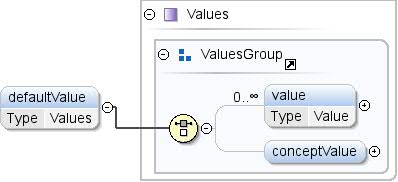 |
| Tipo |
Valores |
| Propiedades |
| content: |
complejo |
| mín.Ocurre: |
0 |
|
| Modelo |
value* | conceptValue{0,1} |
| Niños |
conceptValue, valor |
| Instancia |
<defaultValue>
<value lang="">{0,unbounded}</value>
<conceptValue concept="">{0,1}</conceptValue>
</defaultValue>
|
| Fuente |
<xs:element name="defaultValue" type="Values" minOccurs="0">
<xs:annotation>
<xs:documentation>A default value for the concept, to be used by
applications when they need to pick one of the possible
values of the concept.</xs:documentation>
</xs:annotation>
</xs:element>
|
Elemento: Concepto / tabla
| Espacio de nombres |
http://schemas.google.com/dspl/2010 |
| Anotaciones |
Una referencia a una tabla que contiene todos los valores posibles
del concepto y sus propiedades no constantes. |
| Diagrama |
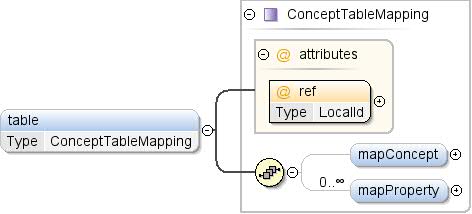 |
| Tipo |
ConceptTableMapping |
| Propiedades |
| content: |
complejo |
| mín.Ocurre: |
0 |
|
| Modelo |
mapConcept{0,1} , mapProperty* |
| Niños |
mapConcept y mapProperty |
| Instancia |
<table ref="">
<mapConcept toColumn="">{0,1}</mapConcept>
<mapProperty lang="" ref="" toColumn="">{0,unbounded}</mapProperty>
</table>
|
| Atributos |
| QName |
Tipo |
Fijo |
Predeterminado |
Usar |
Anotación |
| referencia |
LocalId |
|
|
obligatorio |
El ID de la tabla que contiene los datos del
un concepto de diseño de producto. |
|
| Fuente |
<xs:element name="table" type="ConceptTableMapping" minOccurs="0">
<xs:annotation>
<xs:documentation>A reference to a table that contains all the
possible values for the concept and its non-constant
properties.</xs:documentation>
</xs:annotation>
</xs:element>
|
Tipo complejo: concepto
| Espacio de nombres |
http://schemas.google.com/dspl/2010 |
| Anotaciones |
Un concepto es una definición de un tipo de datos que aparece en el
conjunto de datos (p.ej., "PIB" o “Condado”). Un concepto puede ser
asociada con una enumeración de todos sus valores posibles o no. R
concepto definido en algún conjunto de datos puede ser referenciado en otros
conjuntos de datos. |
| Diagrama |
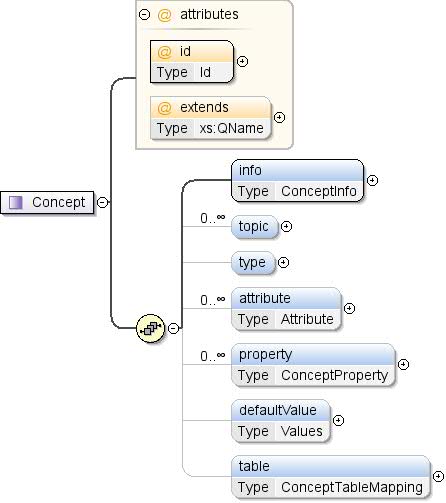 |
| Utilizado por |
|
| Modelo |
información , tema* , tipo{0,1} ,
atributo* , propiedad* , defaultValue{0,1} , tabla{0,1} |
| Niños |
attribute, defaultValue, info,
propiedad, tabla, tema,
tipo |
| Atributos |
| QName |
Tipo |
Fijo |
Predeterminado |
Usar |
Anotación |
| extiende |
xs:QName |
|
|
opcional |
Es el identificador único de un concepto que este concepto
se extiende. El concepto al que se hace referencia se puede definir en el mismo conjunto de datos
o externamente, es decir, en otro conjunto de datos. Es una referencia a un elemento
el concepto debe tener el formato “prefix:other_concept_id”,
en el que “prefijo” es el prefijo que se usa para el espacio de nombres de
el conjunto de datos externo (consulta los espacios de nombres XML). |
| id |
ID |
|
|
obligatorio |
El identificador único del concepto, que debe ser
únicos a nivel global dentro del conjunto de datos. |
|
| Fuente |
<xs:complexType name="Concept">
<xs:annotation>
<xs:documentation>A concept is a definition of a type of data that appears in the
dataset (e.g., "GDP" or "County"). A concept may be associated with
an enumeration of all its possible values or not. A concept defined in
some dataset may be referenced in other datasets.</xs:documentation>
</xs:annotation>
<xs:sequence>
<xs:element name="info" type="ConceptInfo">
<xs:annotation>
<xs:documentation>Textual information, such as the name and description of
the concept.</xs:documentation>
</xs:annotation>
</xs:element>
<xs:element name="topic" minOccurs="0" maxOccurs="unbounded">
<xs:annotation>
<xs:documentation>A topic the concept is associated with.</xs:documentation>
</xs:annotation>
<xs:complexType>
<xs:attribute name="ref" type="xs:QName">
<xs:annotation>
<xs:documentation>The unique identifier of the topic this concept is
associated with.
The referenced topic may be defined in the same
dataset or externally, i.e., in another dataset. A
reference to an external topic must be of the form
"prefix:other_topic_id", where "prefix" is the prefix
used for the namespace of the external dataset (see
XML namespaces).</xs:documentation>
</xs:annotation>
</xs:attribute>
</xs:complexType>
</xs:element>
<xs:element name="type" minOccurs="0">
<xs:annotation>
<xs:documentation>The data type of the concept. A concept must provide a type declaration or extend
another concept. In the case where it's extending a concept, it may also
provide a type declaration. The type of the extended concept must be less restrictive
than the type of the concept extending it.
"Less restrictive than" (LRT) is a partial order defined as follows:
string LRT float
float LRT integer
string LRT date
string LRT boolean</xs:documentation>
</xs:annotation>
<xs:complexType>
<xs:attribute name="ref" type="DataType" use="required"/>
</xs:complexType>
</xs:element>
<xs:element name="attribute" type="Attribute" minOccurs="0" maxOccurs="unbounded">
<xs:annotation>
<xs:documentation>An attribute of the concept. Attributes represent additional
information about the concept (e.g., GDP is a percentage).</xs:documentation>
</xs:annotation>
</xs:element>
<xs:element name="property" type="ConceptProperty" minOccurs="0" maxOccurs="unbounded">
<xs:annotation>
<xs:documentation>A property of the concept. Properties represent additional
information about instances of the concept (e.g., a concept
"city" may have a property "country").</xs:documentation>
</xs:annotation>
</xs:element>
<xs:element name="defaultValue" type="Values" minOccurs="0">
<xs:annotation>
<xs:documentation>A default value for the concept, to be used by
applications when they need to pick one of the possible
values of the concept.</xs:documentation>
</xs:annotation>
</xs:element>
<xs:element name="table" type="ConceptTableMapping" minOccurs="0">
<xs:annotation>
<xs:documentation>A reference to a table that contains all the
possible values for the concept and its non-constant
properties.</xs:documentation>
</xs:annotation>
</xs:element>
</xs:sequence>
<xs:attribute name="id" type="Id" use="required">
<xs:annotation>
<xs:documentation>The unique identifier of the concept, which must be globally
unique within the dataset.</xs:documentation>
</xs:annotation>
</xs:attribute>
<xs:attribute name="extends" type="xs:QName" use="optional">
<xs:annotation>
<xs:documentation>The unique identifier of a concept that this
concept extends.
The referenced concept may be defined in the same
dataset or externally, i.e., in another dataset. A
reference to an external concept must be of the form
"prefix:other_concept_id", where "prefix" is the
prefix used for the namespace of the external
dataset (see XML namespaces).</xs:documentation>
</xs:annotation>
</xs:attribute>
</xs:complexType>
|
| Espacio de nombres |
No hay espacios de nombres |
| Anotaciones |
El identificador único del tema asociado a este concepto
tus amigos. El tema al que se hace referencia se puede definir en el mismo conjunto de datos o
externa, es decir, en otro conjunto de datos. Una referencia a un tema externo
debe tener el formato "prefix:other_topic_id", donde
"prefijo" es el prefijo que se usa para el espacio de nombres del
(consulta los espacios de nombres XML). |
| Tipo |
xs:QName |
| Propiedades |
|
| Utilizado por |
|
| Fuente |
<xs:attribute name="ref" type="xs:QName">
<xs:annotation>
<xs:documentation>The unique identifier of the topic this concept is
associated with.
The referenced topic may be defined in the same
dataset or externally, i.e., in another dataset. A
reference to an external topic must be of the form
"prefix:other_topic_id", where "prefix" is the prefix
used for the namespace of the external dataset (see
XML namespaces).</xs:documentation>
</xs:annotation>
</xs:attribute>
|
| Espacio de nombres |
No hay espacios de nombres |
| Tipo |
DataType |
| Propiedades |
| utiliza esto: |
obligatorio |
|
| Facetas |
| enumeración |
string |
|
| enumeración |
float |
|
| enumeración |
integer |
|
| enumeración |
boolean |
|
| enumeración |
fecha |
|
| enumeración |
concepto |
|
|
| Utilizado por |
|
| Fuente |
<xs:attribute name="ref" type="DataType" use="required"/>
|
| Espacio de nombres |
No hay espacios de nombres |
| Anotaciones |
El identificador único del concepto, que debe ser globalmente
únicos en el conjunto de datos. |
| Tipo |
ID |
| Propiedades |
| utiliza esto: |
obligatorio |
|
| Facetas |
|
| Utilizado por |
|
| Fuente |
<xs:attribute name="id" type="Id" use="required">
<xs:annotation>
<xs:documentation>The unique identifier of the concept, which must be globally
unique within the dataset.</xs:documentation>
</xs:annotation>
</xs:attribute>
|
Atributo: Concepto / @extends
| Espacio de nombres |
No hay espacios de nombres |
| Anotaciones |
Es el identificador único de un concepto que extiende este concepto.
El concepto al que se hace referencia se puede definir en el mismo conjunto de datos o de manera externa.
es decir, en otro conjunto de datos. Una referencia a un concepto externo debe ser
el formato "prefix:other_concept_id", donde "prefix" es
el prefijo utilizado para el espacio de nombres del conjunto de datos externo (consulta XML
espacios de nombres). |
| Tipo |
xs:QName |
| Propiedades |
|
| Utilizado por |
|
| Fuente |
<xs:attribute name="extends" type="xs:QName" use="optional">
<xs:annotation>
<xs:documentation>The unique identifier of a concept that this
concept extends.
The referenced concept may be defined in the same
dataset or externally, i.e., in another dataset. A
reference to an external concept must be of the form
"prefix:other_concept_id", where "prefix" is the
prefix used for the namespace of the external
dataset (see XML namespaces).</xs:documentation>
</xs:annotation>
</xs:attribute>
|
Se crea con el
Editor XML de oXygen.
Salvo que se indique lo contrario, el contenido de esta página está sujeto a la licencia Atribución 4.0 de Creative Commons, y los ejemplos de código están sujetos a la licencia Apache 2.0. Para obtener más información, consulta las políticas del sitio de Google Developers. Java es una marca registrada de Oracle o sus afiliados.
Última actualización: 2025-07-25 (UTC)
[[["Fácil de comprender","easyToUnderstand","thumb-up"],["Resolvió mi problema","solvedMyProblem","thumb-up"],["Otro","otherUp","thumb-up"]],[["Falta la información que necesito","missingTheInformationINeed","thumb-down"],["Muy complicado o demasiados pasos","tooComplicatedTooManySteps","thumb-down"],["Desactualizado","outOfDate","thumb-down"],["Problema de traducción","translationIssue","thumb-down"],["Problema con las muestras o los códigos","samplesCodeIssue","thumb-down"],["Otro","otherDown","thumb-down"]],["Última actualización: 2025-07-25 (UTC)"],[],["Concepts, within a dataset (namespace: `http://schemas.google.com/dspl/2010`), define data types and are globally unique. Concepts can extend others, using `prefix:other_concept_id` for external references. They include `info` (textual details), `topic` (associated topics via `ref`), `type` (data type, `ref`), `attribute` (additional information), `property` (instance information), `defaultValue`, and `table` (data source, `ref`). Key concept attributes are `id` (unique), and `extends` (referencing another concept). External references are in `prefix:identifier` format. A concept must have a `type` or `extends`.\n"]]








